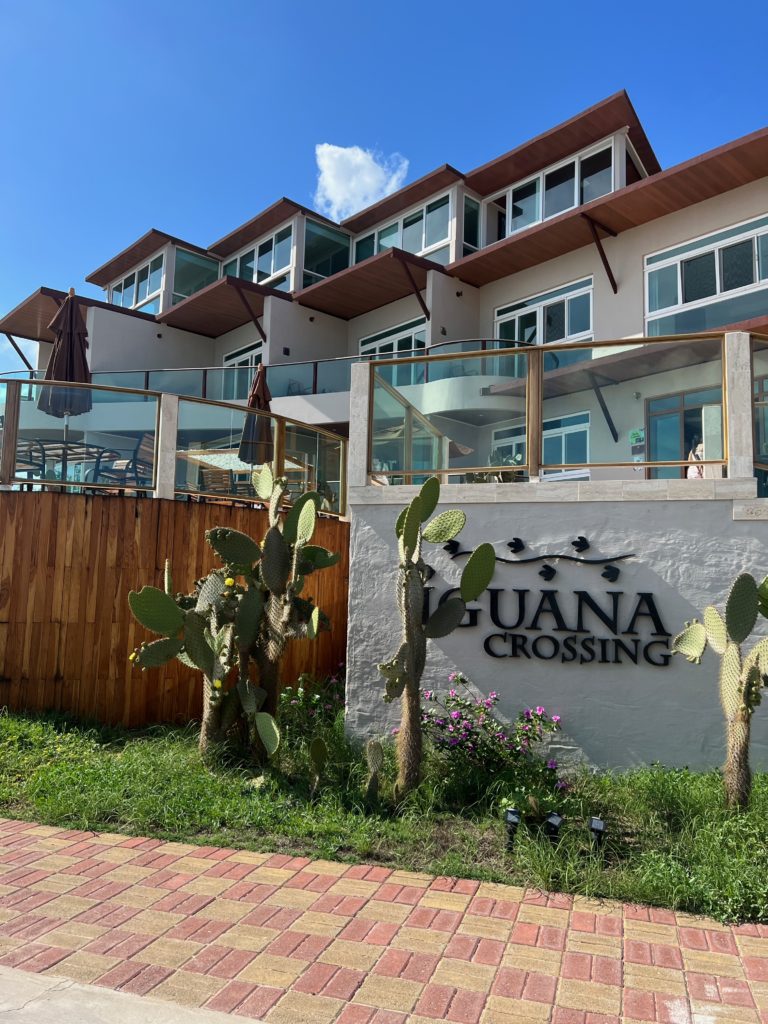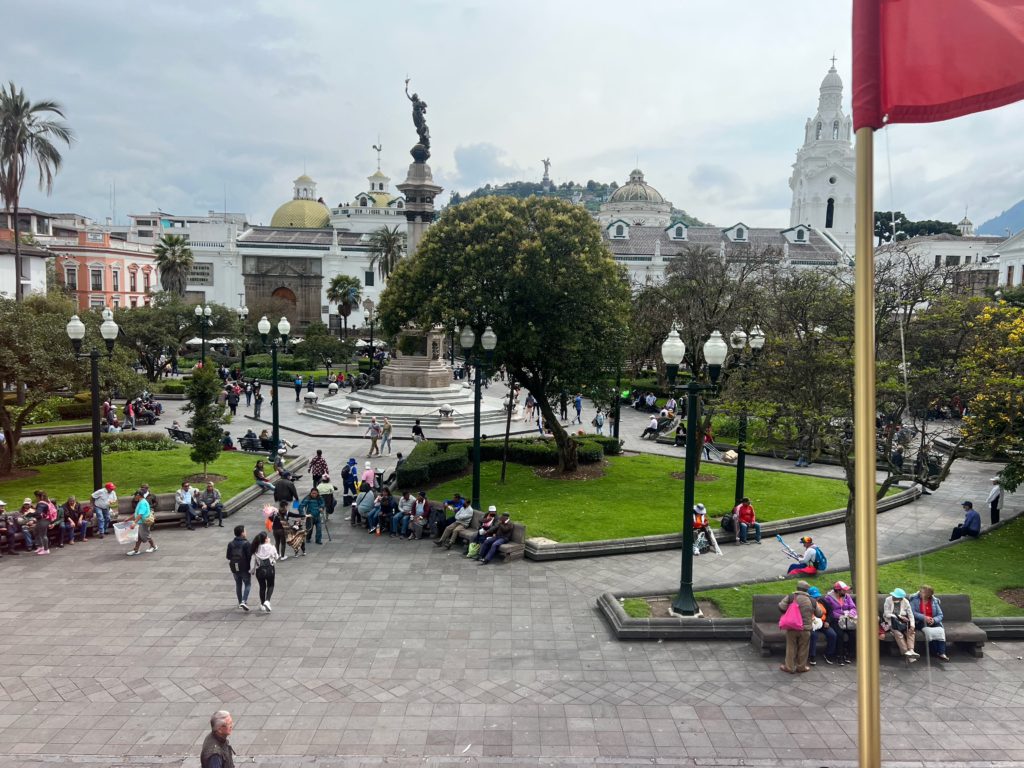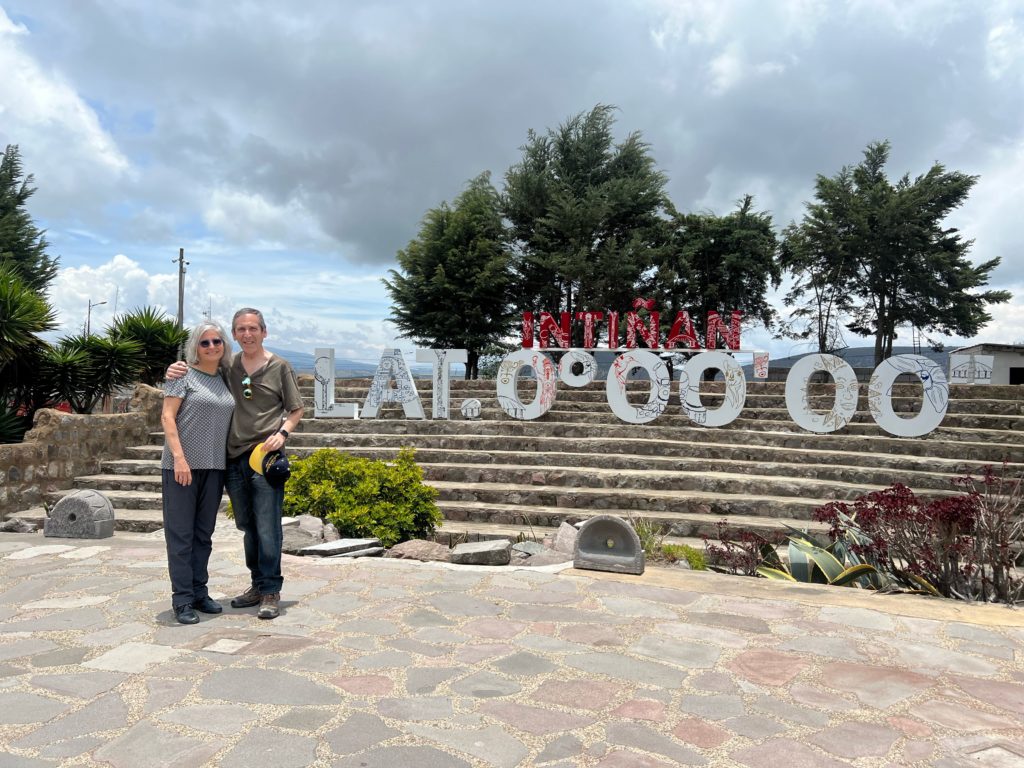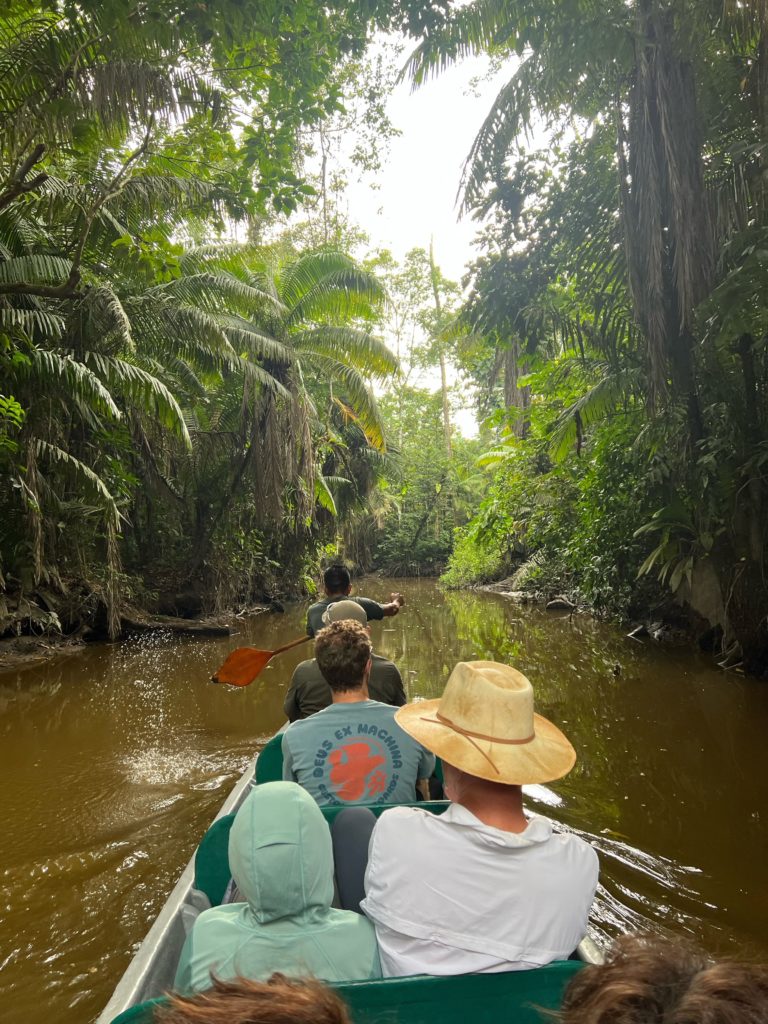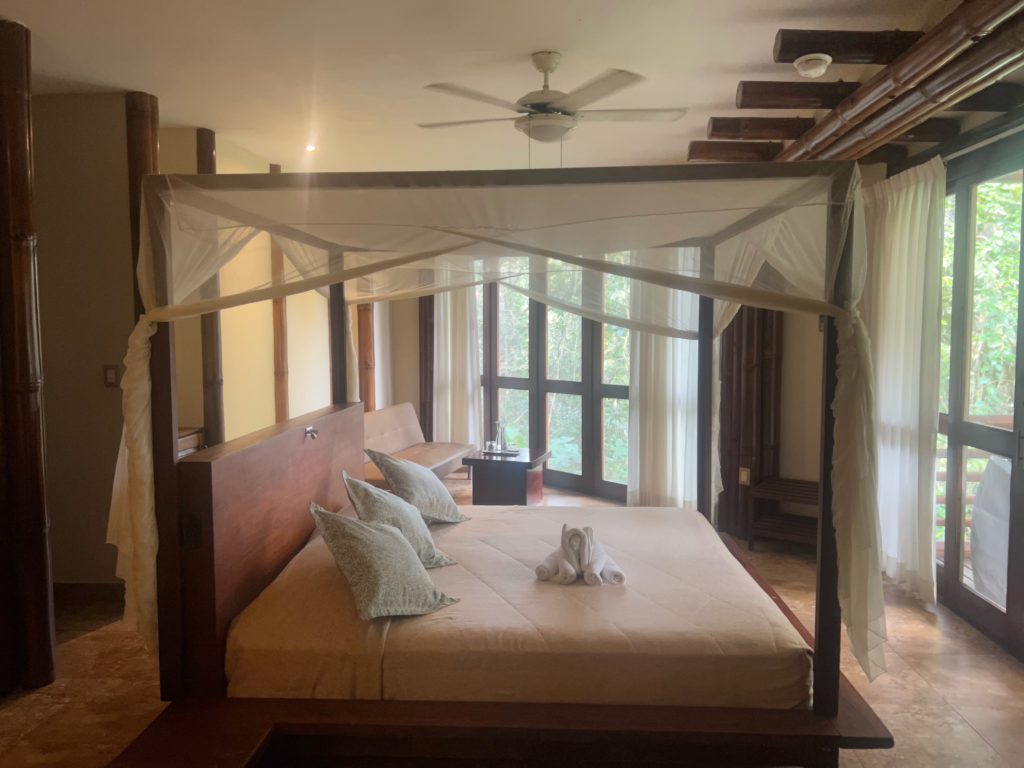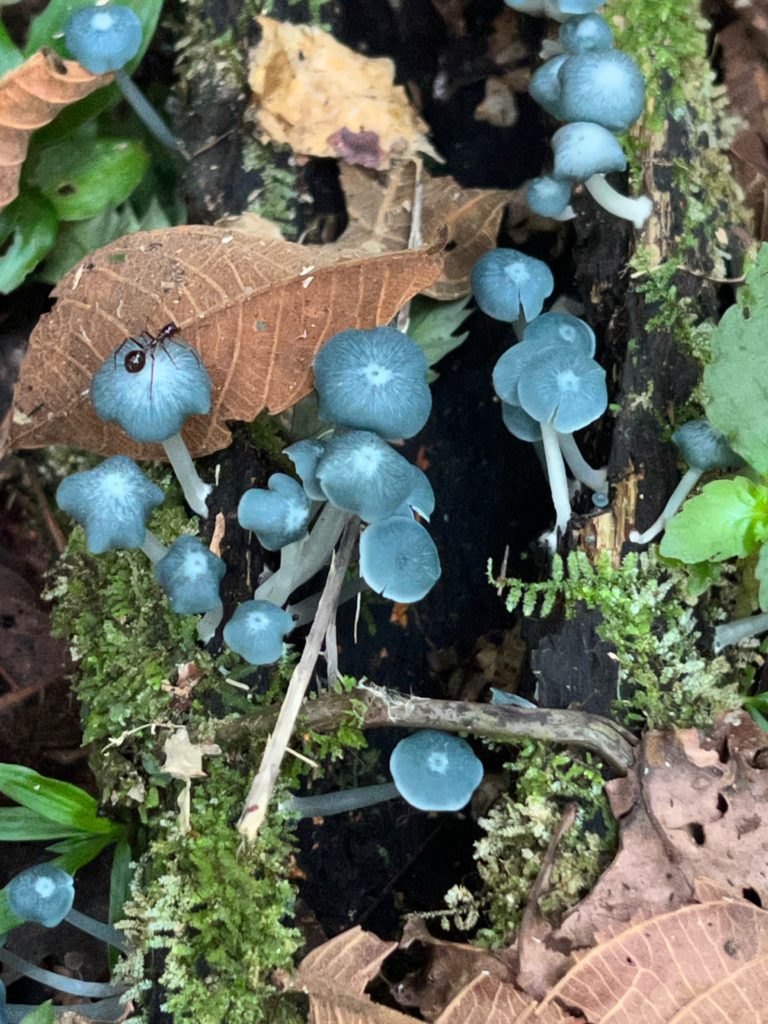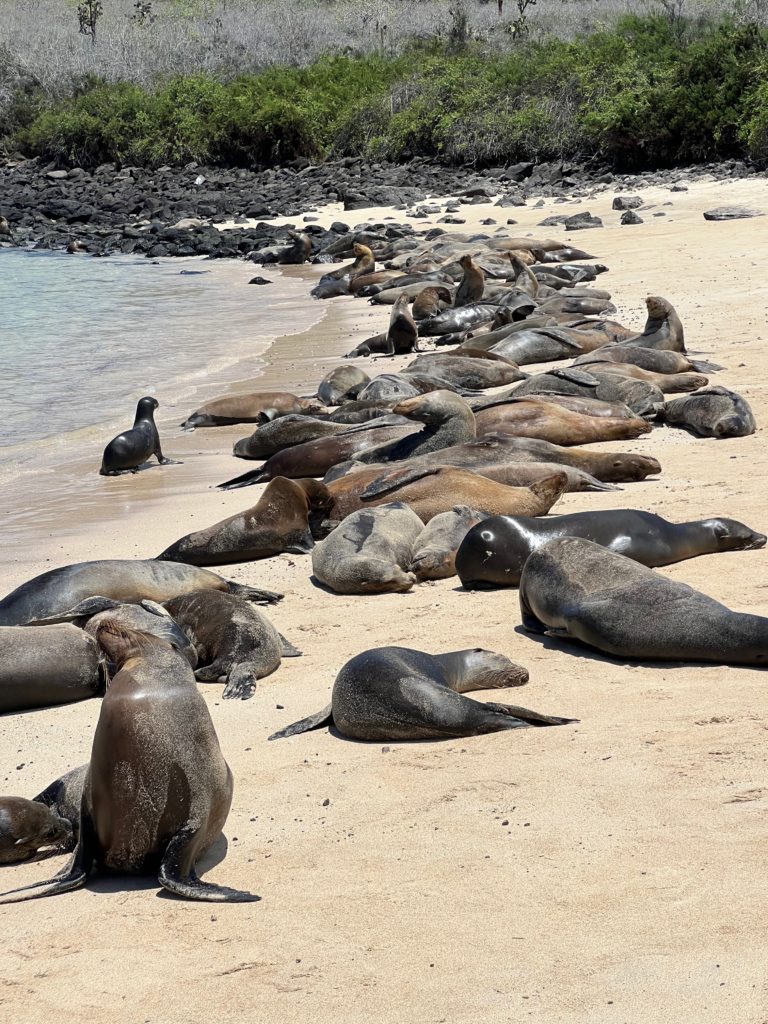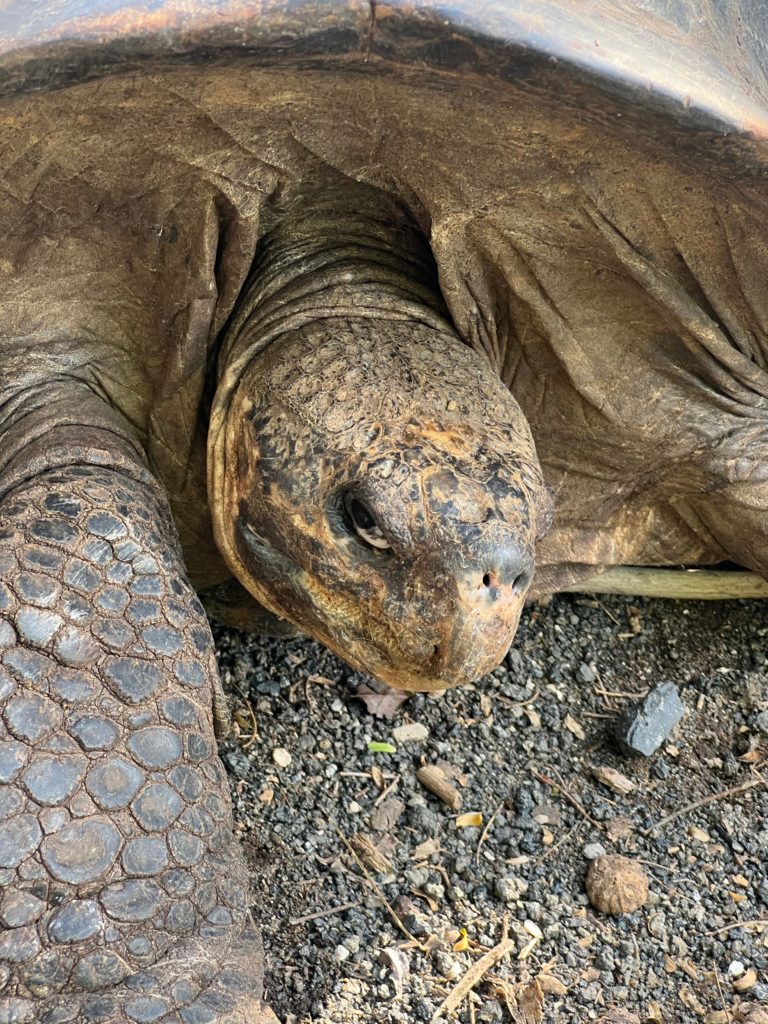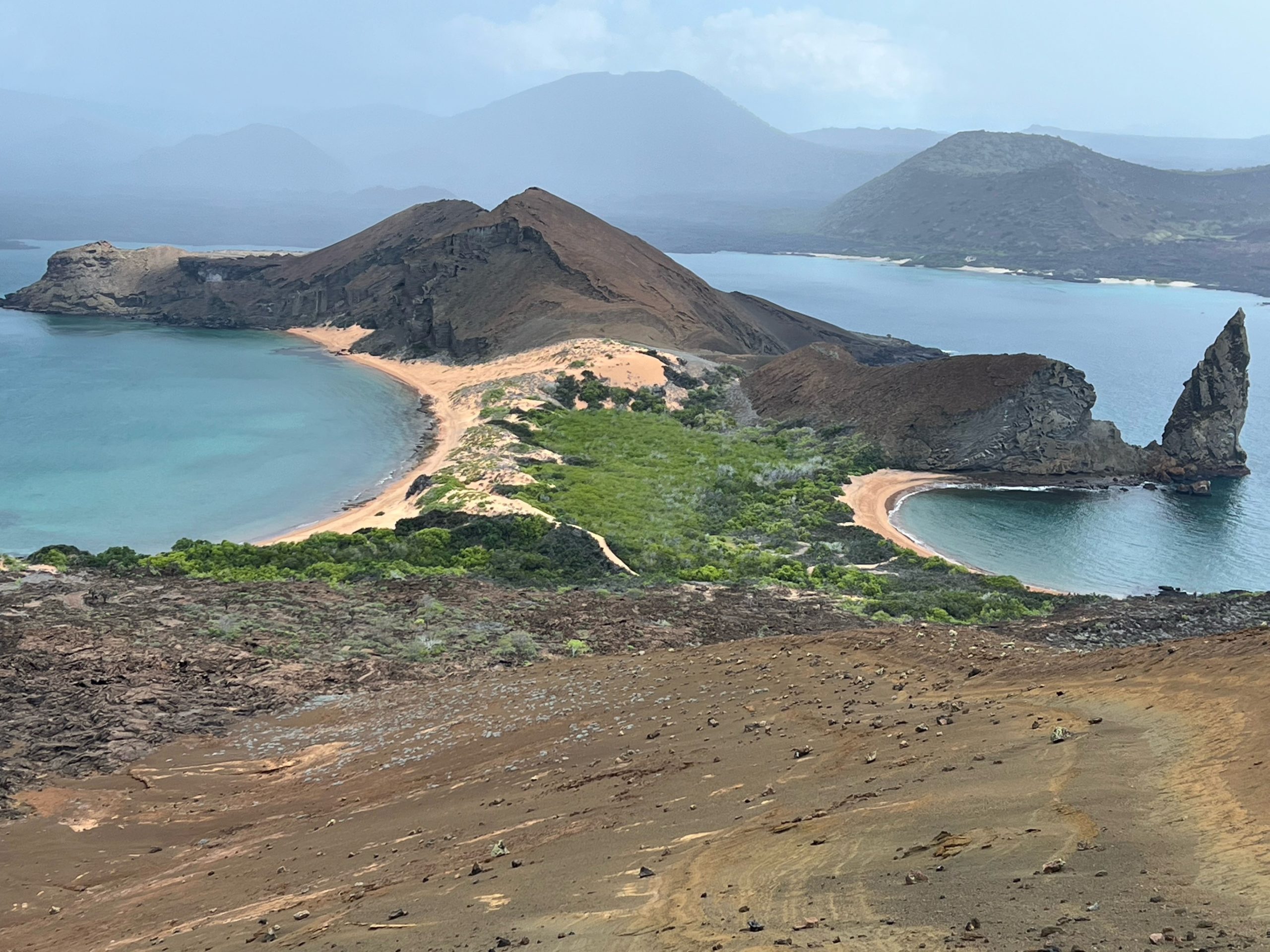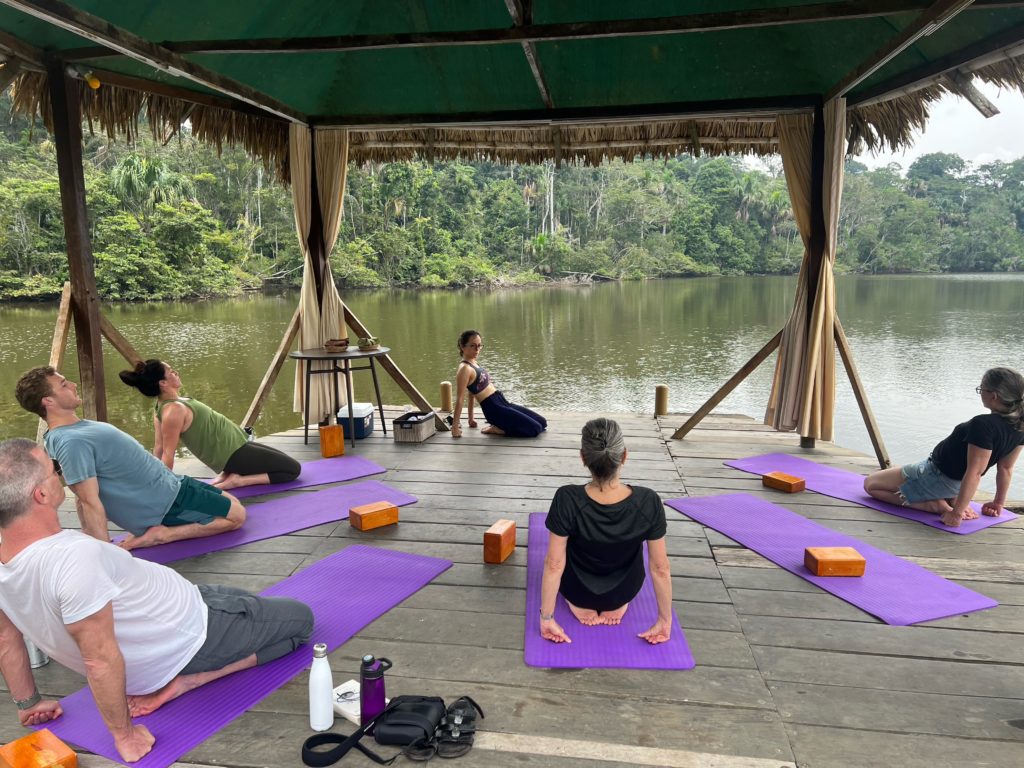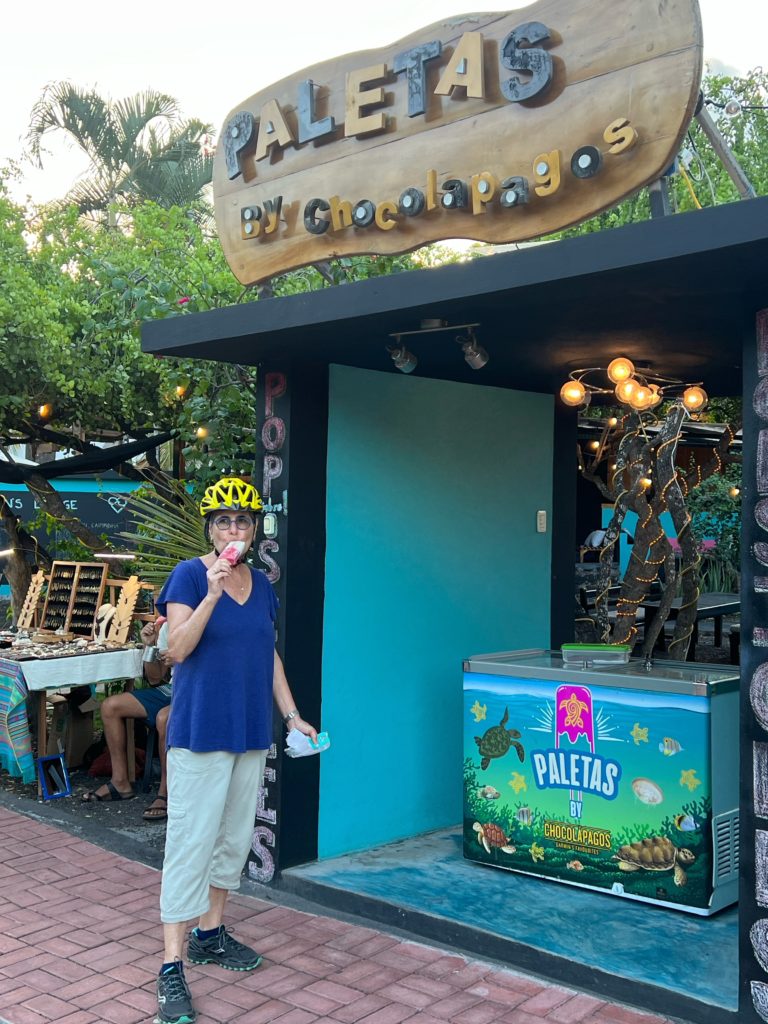We had been warned about the shower.
The proprietors of the Iguana Crossing Hotel on the sparsely populated island of Isabella in the Galapagos were proud of the system they’d implemented. The shower water would turn off every seven seconds, at which point you would have to press a button to restart it. Alternatively, you could have a partner join you and hold the button down while you cleaned the suds off – a cumbersome if somewhat more romantic option.
The Iguana Crossing’s logic was hard to argue with: The Galapagos has very few sources of fresh water, so it relies on water shipped in from the Ecuadorian mainland or from desalination. The seven second system is a tangible way to demonstrate the hotel’s sustainability chops.
Imagine our surprise, then, when we got to our room and there was no button. It was just a normal shower with a steady flow.
“Oh, that’s because you’re on the third floor,” Jonah, the night manager, told me. “It was built for the owners’ family when they visit from the mainland. They wanted regular showers. But when the owners aren’t here, we book the rooms for outside guests.”
The shower was just one of many surprises awaiting my wife, Jody, and me as we spent 13 days in Ecuador. Isabella was our last stop. We flew from Tel Aviv to New York and, after a few days in New York, we continued on to Quito.
Quito in the sky
The first thing we loved about Quito was its airport, which was built around the same time and is visually reminiscent of the current Ben-Gurion Airport in Israel. It is modern, efficient and pleasant with just a single easy-to-navigate terminal. Our Quito guide, Giovanni, met us and drove us the hour-long journey into the city’s Old Town, which in 1978 was the first city to be declared a UNESCO World Heritage status with its evocative colonial architecture, large plazas and abundant churches.
Quito is also high up – at 2,850 meters, its elevation is no less than Jomsom in the Himalayas or Cusco on the way to Machu Picchu. That means you can easily get winded walking around.
As we were eating lunch at a restaurant along the main square where the president’s house is located, a loud ruckus broke out. Protesters blowing horns chanted in Spanish calling for a change in the government. Giovanni was eager to share with us highlights of the political problems beleaguering his country following a turn to the Right several years ago.`
We’d hoped for a slight break from the protests back home. No such luck.
Quito is right on the equator. That means the sun rises every day at 6 am and sets at 6 pm no matter the season. (“Ecuador” comes from the word equator, something I should have known but didn’t.) The Mitad del Mundo – the museum at the “middle of the world” – about a 45-minute drive out of town, is informative and fun. Take a selfie in front of the “latitude 0,0,0” mark.
No-rain rainforest
I have long been fascinated by the prospect of visiting the Amazon. To reach the rain forest, you take a 35-minute plane ride from Quito to Coca, a bustling town on the edge of nowhere.
From Coca, we took a two-hour motorized canoe on the Napo River (the Amazon River itself doesn’t flow through the Ecuadorian part of the jungle), then transferred to a paddle canoe for another half hour before we reached La Selva Lodge, our home for the next five days. La Selva is situated on a lovely lake home to multitudes of piranhas and caiman (a relative of the crocodile). The latter moved in during the height of the pandemic, when the lodge – along with much of Ecuador – was shut down.
Ecuador was hard hit by Covid. Giovanni, our Quito guide, has one of the most tragic Covid stories I’ve heard – he lost his mother and three siblings in a single month.
Our room featured a large bed with mosquito netting and a waterfall shower, but no windows, just bug screens. In the dining hall, gourmet meals were served. At the end of a long path leading halfway into the jungle is an open-air spa with a nice variety of massage treatments. There’s no air conditioning and the ever-present ceiling fans attempt – but never entirely succeed – to ameliorate the intense humidity of the rainforest, which rarely dips below 80%.
Each day, our naturalist guide Sebastian and his machete-wielding local sidekick Enrique led us on walks and more canoe trips (was this the inspiration for Disneyland’s Jungle Cruise ride?) through the dense foliage as we searched for animals.
That was harder than you might expect. While a single hectare of rainforest has more biodiversity than all of North America, Sebastian told us, the numbers of actual animals per species are relatively few and the animals tend to stay far away from human visitors – a good pair of binoculars is a must. “Have no expectations” implored Sebastian.
That said, we still saw many different types of birds and an equal number of intriguing insects, plus one recalcitrant sloth. Sebastian made up for mammalian paucity by giving us a comprehensive history of Amazon foliage, including all manner of mushrooms – edible, poisonous and magic.
On our first morning in the rainforest – wakeup call is at 5:30 am because the animals are most active in the morning and late afternoon – I was startled to hear what sounded like a superhighway outside our room.
That jungle jangle turned out to emanate from the local howler monkeys and it was the constant soundtrack to our daily (and one nighttime) excursions. A single howler can sound like Highway 1 at the entrance to Tel Aviv. Combine the howls with the cacophony from the cicadas and frogs and grasshoppers, and it’s clear the jungle is far from deserted.
Other birds we spotted included various parrots and parakeets, macaws, kingfishers, finches, “stinky turkeys,” herons, needle billed ducks, bats, owls, kites, plum-throated cotingas, three kinds of woodpeckers and some lovely and colorful toucans.
On our last canoe excursion, Sebastian took us to a nearby indigenous village to get a feel for local life as well as some interesting delicacies. Anyone up for barbequed beetle larvae? I hear it tastes like chicken. Plantains – related to the common bananas we eat in the West – are everywhere in Ecuadorian cuisine, as chips, mashed like potatoes, ladled in veggie and meat stews.
About the rain: As much as I don’t like rain, I was prepared to get wet. This was a rainforest, after all. And yet, the rain never came…until the last day when, miraculously, the skies opened a minute after we’d returned from a two-hour open canoe ride. It poured again while we were eating dinner, but we never had to pull out our ponchos or umbrellas. The lodge provides all that, if you need, as well as rubber boots for traversing watery pathways.
Hiking in the Amazon can be challenging, especially when it’s wet, but you return from your morning excursion no later than 11:30 am and the afternoon one doesn’t start until 4 pm, giving you plenty of time for a massage or yoga facing the lake.
Animals in your face
The Galapagos – an archipelago of 13 major islands – is a markedly different ecosystem from the Amazon. It’s mostly barren, essentially a collection of volcanic rocks and lava flows, dotted with prickly pear cacti (the same that we find in Israel). There’s vegetation for sure, including lush greenery on the way up to the Sierra Negra volcano, but the main attraction is the fauna, not the flora.
Because the Galapagos is a protected region, the animals have little fear of humans. Some, like the giant tortoises, have no predators on the islands at all, adding to their boldness. We saw sea lions everywhere – on benches at the pier, sunbathing on the rocks. We toured the “bachelor beach,” where the non-alpha males patiently wait to try their luck at joining a herd and becoming an alpha themselves.
Puerto Ayora on Santa Cruz Island, our first stop, is the Galapagos’ main population center, with 20,000 inhabitants. We loved seeing the wildlife by day and strolling Charles Darwin Avenue by night, with its art shops, souvenir stands and smoothie vendors. Darwin’s presence is felt everywhere – this is, after all, where he conceived his theory of evolution after visiting the islands in 1835.
Isabella Island is more laid back, with just a few restaurants and a main street that’s charmingly unpaved. The iguanas really do cross right in front of the eponymously named hotel on Isabella, which is situated not far from a small flamboyance of flamingos (yes, that’s what a group of flamingos is called). You’ll also find frigates, pelicans, yellow warblers and crabs of all shapes and colors.
Both Santa Cruz and Isabella have tortoise breeding centers. Tortoises were hunted for their meat and oil before the Galapagos became a national park in 1959. The breeding centers allow young tortoises to mature without risk of being eaten by angry birds. When they turn five-years-old and their shells are sufficiently hardened, the tortoises are returned to the exact location where the eggs were collected. We were particularly taken with a unique local species with a long giraffe-like neck for reaching higher-up vegetation.
There are two ways to “do” the Galapagos. You either cruise for a few days to a few weeks, or you can stay on land. We opted for the latter because both Jody and I tend to get seasick. We were happy with our choice because that allowed us to get to know the towns better.
Land-based programs include day tours by yacht or speed boat that usually feature a short walk on one of the islands beyond the main ones, followed by snorkeling and lunch. The yachts have all the gear you need. Bring both water shoes and hiking boots – you’ll need the former for “wet landings” where the dingy can’t land directly on the beach, and the latter for hiking over those volcanic rocks.
The name of our tour was the “Penguin Pursuit,” but we only spotted two – one on Bartolomé Island, on one of our day tours, and one off of Isabella while we were preparing to snorkel. On our last day we also caught a glimpse of the islands’ fabled blue-footed boobies.
There are two seasons in the Galapagos. From December to April, it’s warm and wet. The rest of the year is cooler but with less rain. But these are not normal times, so our timing, during the “wet” season, was both hot and dry. And by hot, think of Tel Aviv in August (fortunately, our Galapagos hotels had air conditioning).
Another benefit to the warm season: The water is much more pleasant for snorkeling. (Wetsuits not required.)
We snorkeled three times. We saw translucent green and blue parrot fish, tiny sardines, colorful clown fish, sharks, rays and marine iguanas. But the highlight came on our last day during a day tour to Tintoreras Island when we came across a huge sea turtle swimming to the surface for a breath of air. We followed it, at times snorkeling directly above the turtle, which was entirely nonplussed by the presence of 18 odd creatures with plastic tubes attached to their mouths.
It was a dramatic ending to a trip of a lifetime. If you fancy a vacation based more on animals than monuments, Ecuador has it all.
Just watch out for the howler monkeys on the Amazon superhighway.
If you go…
Ecuador is about as far away from Israel as you can get. We were on a total of 13 flights to and from Israel; the final leg home lasted some 43 hours door-to-door and took us through four countries (and that was the fastest itinerary we could find).
We flew via New York on El Al and then JetBlue to Quito, but you can go through Europe as well. Our return flight on Avianca left at the grueling hour of 3:00 am and stopped for two hours in Bogota, Colombia, on the way home via New York. (The shopping at Bogota’s El Dorado International Airport is fantastic.) That said, Avianca is a budget airline with tiny seats and no legroom – avoid it like the plague!
There are regular flights to the Galapagos from Quito or Guayaquil, Ecuador’s largest city. The plane to Santa Cruz lands on the adjacent island of Baltra. From there you take a bus and a ferry and drive 40 minutes into town. The flight from Baltra to Isabella is on a bumpy eight-seater propeller plane. Fortunately, it’s only a half hour in the air!
While you can handle all the arrangements yourself, we found it easier to work with an Ecuador-based travel agency, Galapagos Island Tours, which booked all our flights, hotels, guides and meals. Word to the wise: Don’t let the agency reserve for you three meals a day. They tend to be more international than local, and you will definitely come home heavier than you left, despite all the hiking and snorkeling.
When you’re in the Amazon, your lodge will organize the tours and guides. We stayed at La Selva, but the nearby Sacha Lodge has the same tours (the only difference, really, is that Sacha doesn’t have a spa. A slightly less pricey alternative, the Napo Wildlife Center, is another option.
We loved the Illa Experience, our hotel in Quito’s Old City, with its breathtaking views of the Virgin of El Panecillo sculpture on a hill in the center of town. The Iguana Crossing in Isabella is highly recommended – if you can get a room on the third floor. In the town of Puerto Ayora on Santa Cruz Island, we stayed at the Ikala Suites, which was equally lovely and has offers free bikes to traverse the town’s extensive bike lanes.
Ecuador switched in 2000 to the U.S. dollar, so it’s easy to figure out how much things cost. Tipping (guides, yacht captains, hotel staff) is always recommended. While our agency took care of almost all our fees, there is a $100 per person Galapagos National Park fee payable at the Quito airport prior to boarding your flight. Another $20 is due for a Galapagos “transit card.” Isabella asks for $10 to enter. Why? No one could explain it in English. All the fees must be paid in cash.
You don’t need any vaccinations to enter Ecuador, although it’s a good idea to get a shot against Yellow Fever which the Amazon mosquitoes can carry.
Finally, if you enjoy a tasty paleta (a South American popsicle), you’ll find those in Puerto Ayora on the road to the Darwin Center, although truth be told, the paletas in Israel are better!
I reviewed our trip to Ecuador first for The Jerusalem Post.
